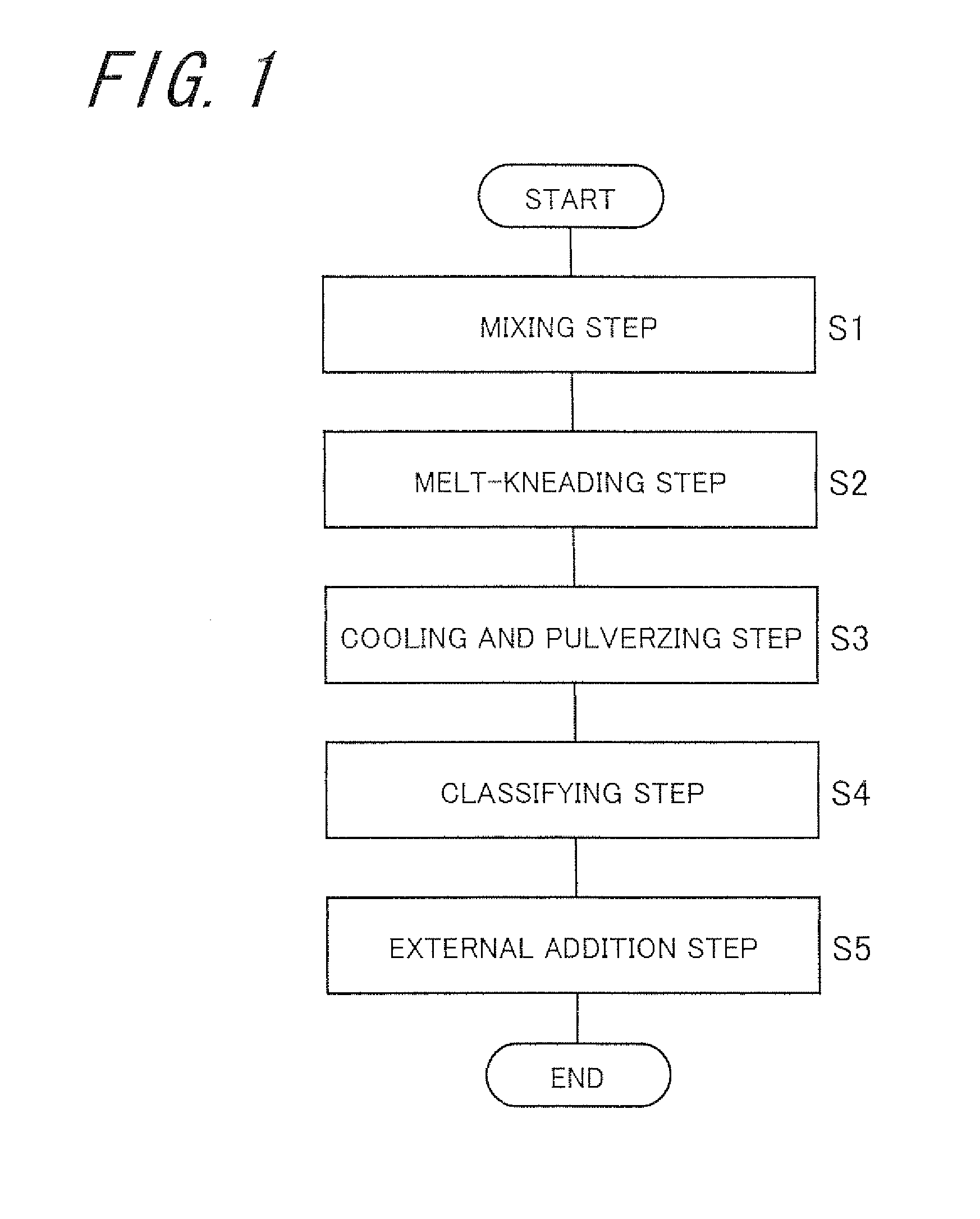Toner and method for manufacturing the same
a technology of toner and manufacturing method, applied in the field of toner, can solve the problems of insufficient fixability of low-temperature toner, unstable amount, and fragile toner, and achieve the effects of excellent charging stability, powder flowability, and fixability
- Summary
- Abstract
- Description
- Claims
- Application Information
AI Technical Summary
Benefits of technology
Problems solved by technology
Method used
Image
Examples
example 1
[0143][Preparation of Polyester Resin A1]
[0144]In a reaction vessel equipped with an agitating device, a heating device, a thermometer, a cooling pipe, a fractionator, and a nitrogen-inducing pipe, 305 g of terephthalic acid, 55 g of isophthalic acid, 1400 g of disproportionated rosin (acid value was 157.2 mgKOH / g), and 30 g of trimellitic anhydride, which will serve as acid components; 300 g of glycerin and 150 g of 1,3-propanediol, which will serve as alcoholic components; 1.79 g of tetra-n-butyltitanate (corresponding to 0.080 part by weight relative to 100 parts by weight of the sum of acid components and alcoholic components) which will serve as reaction catalyst were inputted. These materials were agitated in a nitrogen atmosphere and subjected to the polycondensation reaction for 10 hours at 250° C. while distilling generated water, and after checking the predetermined softening temperature was reached by a flow tester, the reaction was completed, thus a polyester resin A1 (g...
example 2
[0161][Preparation of Polyester Resin A2]
[0162]A polyester resin A2 (glass transition temperature of 55° C., softening temperature of 111° C., weight average molecular weight of 2520, Mw / Mn=1.9, acid value of 11 mgKOH / g, THE insoluble component of 0%) was obtained in the same manner as in the preparation of the polyester resin A1 of Example 1, except that terephthalic acid and trimellitic anhydride were not used but 335 g of isophthalic acid and 1530 g of disproportionated rosin (acid value of 157.2 mgKOH / g) were used as acid components, and only 280 g of glycerin was used as alcoholic components.
[0163]A toner of Example 2 (volume average particle size of 6.7 μm, CV value of 25%, α value of −0.3, β value of 4690) was obtained in the same manner as in Example 1, except that the polyester resin A2 was used instead of the polyester resin A1 at the mixing step S1.
example 3
[0164][Preparation of Polyester Resin A3]
[0165]A polyester resin A3 (glass transition temperature of 65° C., softening temperature of 124° C., weight average molecular weight of 5850, Mw / Mn=4.3, acid value of 10 mgKOH / g, THE insoluble component of 0%) was obtained in the same manner as in the preparation of the polyester resin A1 of Example 1, except that trimellitic anhydride was not used but 230 g of terephthalic acid, 230 g of isophthalic acid, and 1350 g of disproportionated rosin (acid value of 157.2 mgKOH / g) were used as acid components, and 330 g of glycerin and 30 g of 1,3-propanediol were used as alcoholic components.
[0166]A toner of Example 3 (volume average particle size of 6.7 μm, CV value of 24%, α value of −0.3, β value of 4690) was obtained in the same manner as in Example 1, except that the polyester resin A3 was used instead of the polyester resin A1 at the mixing step S1.
PUM
| Property | Measurement | Unit |
|---|---|---|
| Temperature | aaaaa | aaaaa |
| Percent by mass | aaaaa | aaaaa |
| Percent by mass | aaaaa | aaaaa |
Abstract
Description
Claims
Application Information
 Login to View More
Login to View More - R&D
- Intellectual Property
- Life Sciences
- Materials
- Tech Scout
- Unparalleled Data Quality
- Higher Quality Content
- 60% Fewer Hallucinations
Browse by: Latest US Patents, China's latest patents, Technical Efficacy Thesaurus, Application Domain, Technology Topic, Popular Technical Reports.
© 2025 PatSnap. All rights reserved.Legal|Privacy policy|Modern Slavery Act Transparency Statement|Sitemap|About US| Contact US: help@patsnap.com

